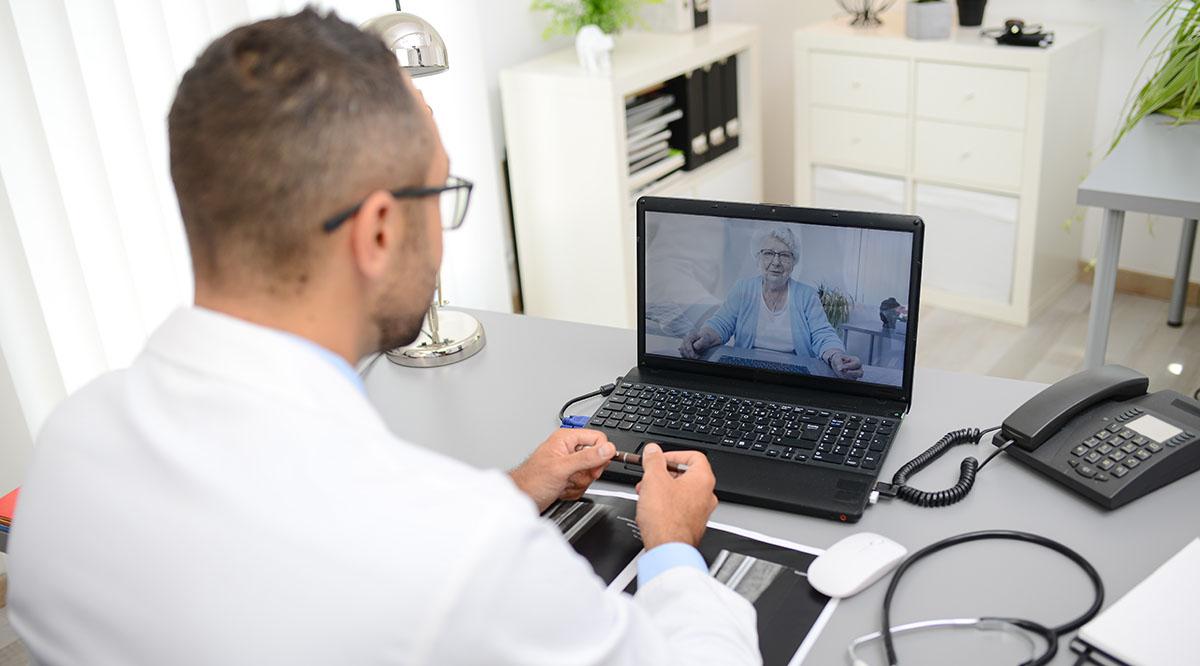Less than 10 days ago, LCMC Health had very few options for telehealth within its five-hospital system serving the greater New Orleans area. Today, with the second highest number of COVID-19 patients per capita in the nation, LCMC Health has quickly rolled out a far-reaching plan to screen and treat emergency department (ED) patients as well as outpatients in every specialty via videoconferencing.
“We just started this last week,” says Scott Mackey, DO, associate chief medical information officer for LCMC Health who is leading the rapidly evolving telemedicine efforts. “We have a COVID hotline, which patients can call to get screened by a nurse. If they screen positive, then we step up the telehealth visit, and they’re connected with one of our emergency department physicians” who has been quarantined but can still evaluate patients.
About 10% of those patients are then directed to the ED at University Medical Center New Orleans, where they are quickly isolated in one of six video-equipped rooms. From there, ED physicians in the hospital continue to evaluate the patient via the HIPAA-compliant videoconferencing platform Zoom, with just one nurse in personal protective equipment (PPE) allowed in the room to take vital signs and draw blood. From there, the patient is either admitted to the hospital or discharged for COVID-19 testing or isolation.
The only limit to the hospital’s expansion? Laptops and iPads. “Last week, I ordered 10 new iPads,” Mackey says. “I have 100 more iPads on order that I should get tomorrow.” By the end of the week, in addition to fully outfitting all of the hospital EDs, he anticipates having 50 clinics equipped to conduct regular outpatient visits in every specialty.
Even before the federal government waived a number of restrictions on reimbursement for telehealth through Medicare last week, academic medical centers around the country had begun to ramp up their own telehealth services, including the ability to remotely triage COVID-19 patients, convert regular ambulatory visits to telehealth visits and, in some cases, deploy sophisticated telehealth technologies to monitor the sickest intensive care unit (ICU) patients.
“If you look at what China did, they did a really bad job initially and then it became apparent that they did a lot of things right. One of the things they did right was that they made 50% of their care virtual.”
John Scott, MD
University of Washington Medicine
The extraordinary measures are necessary not just to effectively serve the rapidly expanding patient population with COVID-19 but also to keep otherwise healthy patients away from the hospital and protect health care providers from the highly infectious and dangerous SARS-CoV-2 pathogen that causes the disease, says John Scott, MD, medical director for digital health at University of Washington (UW) Medicine in Seattle, one of the country’s hardest hit areas.
“If you look at what China did, they did a really bad job initially and then it became apparent that they did a lot of things right,” Scott says. “One of the things they did right was that they made 50% of their care virtual.”
Unprecedented growth in telehealth services
While few hospital systems in the United States have the technological capability to scale up to 50% virtual care, many are nonetheless making rapid and dramatic changes to their telehealth programs.
In the last week, Jefferson Health, already recognized as one of the nation’s leading providers of telehealth services to patients in its 14-hospital network throughout New Jersey and Pennsylvania, has had a tenfold surge in demand for screening through its JeffConnect service, says Judd Hollander, MD, associate dean of strategic health initiatives. “A lot of these people want COVID testing and assessment,” he says. “We used to have just one doctor staffing this at a time. Now we have 10 and that number is going to be even higher tomorrow.”
Jefferson Health is also working frantically to move many of its outpatient visits to telemedicine visits. From just a few dozen visits last week, they are now scheduling 500-600 telemedicine visits per day. “We have scheduled visits across every specialty,” Hollander says. “We’re lucky in the sense that we’ve been implementing this across the enterprise for more than 10 years. Even if our providers only did 12 video visits a year [before the coronavirus pandemic], they know how to do it.”
At the University of Arkansas for Medical Sciences (UAMS), a plan to roll out telemedicine one clinic at a time has evolved into a rush to make most of the hospital’s clinics telemedicine-ready in the next few days, says Curtis Lowery Jr., MD, director of the Institute for Digital Health and Innovation at UAMS. “We’re trying to keep our regular patients out of our clinics,” he says.
Likewise, an initial plan to train all providers to use UAMS’ videoconferencing platform at the university’s training facility has evolved into a push to encourage providers to watch an online training module. “Our plan was to bring [the technology] up sequentially and train everybody in the process but this crisis has created a need to circumvent some of that process.”
Like Jefferson Health, UAMS has a robust and secure online system for handling incoming queries, both for COVID-19-related screening and telemedicine visits. Not surprisingly, though, the surge in demand has placed an enormous strain on the hospitals’ servers. “We have a virtual war room with 15-20 tech people working around the clock to ensure our systems stay online,” Hollander says.
“Before, we had limited use of Zoom for specific patient populations, and there was significant resistance to operationalizing this across the system. Now we have a patient population that is actively searching for the ability to be seen without leaving their homes.”
Philip Bernard, MD
University of Kentucky HealthCare
Other academic systems are embracing existing videoconferencing platforms like Zoom or are expanding their partnerships with commercial telemedicine companies like Amwell and Teledoc.
At the University of Kentucky (UK) HealthCare, providers are rapidly deploying two telehealth options, both using the Zoom videoconferencing platform, says Philip Bernard, MD, chief medical information officer at UK HealthCare. The first is for unscheduled acute care, and the second is for previously scheduled outpatient visits. “Before, we had limited use of Zoom for specific patient populations, and there was significant resistance to operationalizing this across the system,” he says. “Now we have a patient population that is actively searching for the ability to be seen without leaving their homes.”
While age has often been cited as a barrier to the expanded use of telehealth, most providers are finding that older patients are increasingly comfortable with the technology, Mackey says. But other barriers to care, including spotty access to broadband and cellular service in some parts of the country, as well as inconsistent access to cellphones and other technology, could prove challenging for some patients.
More opportunities and challenges
The rapid expansion of telemedicine, both to triage possible COVID-19 patients and to keep non-COVID-19 patients away from the hospital, picked up steam not long after Congress passed the first $8 billion spending plan to combat the virus on March 6. That bill included $500 million to expand telehealth services during the public health emergency.
On March 17, the Centers for Medicare and Medicaid Services (CMS) further paved the way for an expansion of telehealth services by announcing it would lift additional restrictions on telehealth paid for through Medicare, the federal health insurer that covers 62 million Americans age 65 and older. Previously, telehealth visits through Medicare had been restricted to older adults living in rural areas and only for patients who had an already established relationship with a provider and for telehealth care that took place in a rural health care facility. The expansion will allow all Medicare beneficiaries to receive care in their homes through devices that allow for audio and visual communication and will allow providers to bill for those services at the same rate as an in-patient visit.
While noting the importance of payment for long-term sustainability, Hollander noted that his primary goal was to expand access to care as quickly as possible. “I’ve had providers say, ‘Are we getting paid for this?’ And I say, ‘We can’t worry about that now. We’ll figure it out on the back end. We went into medicine to take care of people.’”
“I’ve had providers say, ‘Are we getting paid for this?’ And I say, ‘We can’t worry about that now. We’ll figure it out on the back end. We went into medicine to take care of people.’”
Judd Hollander, MD
Jefferson Health
One hurdle that hasn’t changed even with the federal government’s relaxation of strict telehealth rules is the issue of state licensure for telemedicine services. State licensing rules stipulate that a provider can only provide telehealth care to patients in that same state, which has translated into some physicians having to pay for multiple state licenses – or being unable to provide telehealth care to patients in neighboring states or in states with fewer numbers of stricken COVID-19 patients, for instance.
Several states are considering new regulations to change this rule; New Jersey on Thursday evening passed a law allowing New Jersey providers in good standing to see patients via video visit with whom they have an established patient-provider relationship.
The licensing issue hasn’t been as much of a problem for academic centers that contract with virtual telemedicine companies, as their providers are typically licensed across multiple states. As soon as COVID-19 hit the state of Washington, for instance, UW Medicine leveraged its preexisting virtual clinic through Amwell to help triage potential COVID-19 patients. Furthermore, they provided that service free of charge to any patient 24/7, and not surprisingly, had a tenfold increase in calls. “We thought it was important to provide that service to the community and it’s been utilized quite a bit,” Scott says.
UW Medicine is also rapidly scaling up its ability to see many of its non-COVID-19 patients via video visit and has been training clinicians in all 45 specialties to provide telemedicine visits, hopefully by the end of the week, Scott says.
With a rapidly growing patient population in need of intensive care, and with a critical shortage of PPE, UW Medicine also made the call last week to purchase 20 additional InTouch robots to help staff ICUs. “Our intensivists can provide expert advice” through the robots, which UW Medicine already uses in its telestroke program, Scott says.
He says there’s no way to know for sure what’s coming, but public health efforts to limit social contact are critical. “It’s like a Category 5 hurricane is coming and you don’t know if it’s going to be a direct hit or if it’s going to veer off to the side. In China, they did virtual care but they also did mass quarantining and social distancing. Hong Kong and Singapore also did that social distancing and contact tracing and they’ve been able to keep a lid on it. It will be interesting to see what happens here. I think the United States is in for quite a ride.”

